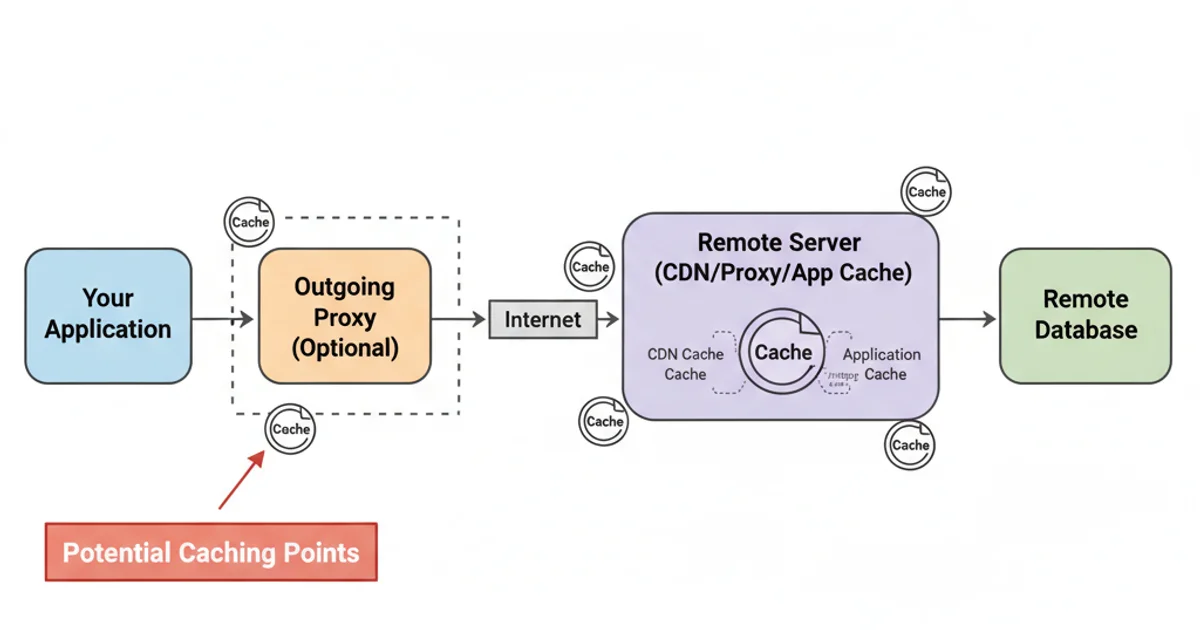cURL refuses to ignore cache
Categories:
cURL Refuses to Ignore Cache: Troubleshooting and Solutions

Learn how to effectively prevent cURL from caching responses, especially in PHP and CakePHP environments, by understanding common pitfalls and implementing robust cache-busting strategies.
When working with cURL, especially in PHP applications like CakePHP, you might encounter situations where cURL seems to ignore your requests to fetch fresh data, instead returning stale, cached responses. This can be particularly frustrating when debugging APIs or integrating with services that frequently update their data. This article will delve into the common reasons why cURL might appear to be caching responses and provide practical solutions to ensure you always get the latest data.
Understanding cURL's Caching Behavior
It's important to clarify that cURL itself, as a library, does not inherently implement a caching mechanism for HTTP responses. If you're experiencing caching, it's almost always due to external factors. These factors can include:
- Server-Side Caching: The remote server you are querying might be caching responses and serving stale content. This is common with CDNs, reverse proxies (like Varnish, Nginx), or application-level caching on the target server.
- Proxy Server Caching: If your application is behind an outgoing proxy server, that proxy might be caching responses.
- DNS Caching: While less common for HTTP response caching, stale DNS records can sometimes lead to requests being routed to an old server instance, which might then serve cached content.
- Client-Side (Application) Caching: Your own application code (e.g., CakePHP's caching mechanisms, or a custom cache layer) might be storing and serving previous cURL results without re-fetching.

Potential caching points in a cURL request lifecycle
Strategies to Force Fresh cURL Responses
To ensure cURL fetches fresh data, you need to implement strategies that bypass or invalidate caching at various points in the request chain. The most effective methods involve manipulating HTTP headers and URL parameters.
1. 1. Add Cache-Control Headers
The Cache-Control header is the primary mechanism for controlling caching behavior. Sending no-cache, no-store, and must-revalidate directives tells intermediate caches and the origin server not to serve cached content without revalidation or not to store it at all.
2. 2. Include Pragma: no-cache Header
While Cache-Control is the modern standard, Pragma: no-cache is an older HTTP/1.0 header that can still be useful for compatibility with older proxy servers.
3. 3. Append a Unique Query Parameter
Adding a unique, non-functional query parameter (e.g., a timestamp or a random string) to the URL is a highly effective way to bypass caches. Most caches treat URLs with different query strings as distinct resources, forcing a fresh fetch.
4. 4. Set Connection: close Header
Although less directly related to caching, setting Connection: close can sometimes prevent persistent connections from being reused, which in rare cases might be associated with stale responses if the server-side connection pooling is misconfigured.
5. 5. Disable cURL's Internal Connection Pooling (if applicable)
For some cURL versions or configurations, CURLOPT_FORBID_REUSE or CURLOPT_FRESH_CONNECT can force cURL to establish a new connection for each request, bypassing any potential connection-level caching or reuse issues. However, these options can impact performance.
PHP cURL Implementation Example
Here's how you can implement these cache-busting strategies in a PHP cURL request.
<?php
function fetch_fresh_data($url) {
$ch = curl_init();
// 1. Append a unique query parameter (timestamp)
$url_with_cache_buster = $url . (strpos($url, '?') === false ? '?' : '&') . 'cache_buster=' . microtime(true);
curl_setopt($ch, CURLOPT_URL, $url_with_cache_buster);
curl_setopt($ch, CURLOPT_RETURNTRANSFER, true);
curl_setopt($ch, CURLOPT_HEADER, false); // Don't return headers in response body
// 2. Set Cache-Control and Pragma headers
curl_setopt($ch, CURLOPT_HTTPHEADER, [
'Cache-Control: no-cache, no-store, must-revalidate',
'Pragma: no-cache',
'Expires: 0', // For HTTP/1.0 proxies
'Connection: close' // Optional: force new connection
]);
// 3. Optional: Force a new connection
// curl_setopt($ch, CURLOPT_FRESH_CONNECT, true);
// curl_setopt($ch, CURLOPT_FORBID_REUSE, true);
$response = curl_exec($ch);
if (curl_errno($ch)) {
echo 'cURL Error: ' . curl_error($ch);
return false;
}
curl_close($ch);
return $response;
}
// Example usage:
$api_endpoint = 'https://api.example.com/data';
$data = fetch_fresh_data($api_endpoint);
if ($data) {
echo "Fetched fresh data:\n";
echo $data;
} else {
echo "Failed to fetch data.";
}
?>
CakePHP Specific Considerations
In a CakePHP application, you might be using Http ewClient() or Http ewRequest() for making HTTP requests. While these internally use cURL, the principles remain the same. Ensure you pass the correct headers and query parameters.
<?php
// In a CakePHP Controller or Component
use Cake\Http\Client;
class MyController extends AppController
{
public function fetchDataFromApi()
{
$http = new Client();
$api_endpoint = 'https://api.example.com/data';
// Append a unique query parameter
$query_params = ['cache_buster' => microtime(true)];
// Set cache-busting headers
$headers = [
'Cache-Control' => 'no-cache, no-store, must-revalidate',
'Pragma' => 'no-cache',
'Expires' => '0',
'Connection' => 'close'
];
try {
$response = $http->get($api_endpoint, $query_params, [
'headers' => $headers,
// Optional: force fresh connect if using lower-level curl options
// 'curl' => [
// CURLOPT_FRESH_CONNECT => true,
// CURLOPT_FORBID_REUSE => true,
// ]
]);
if ($response->isOk()) {
$data = $response->getStringBody();
$this->set('apiData', $data);
$this->viewBuilder()->setOption('serialize', ['apiData']);
} else {
// Handle error
$this->Flash->error('Failed to fetch data: ' . $response->getStatusCode());
}
} catch (\Exception $e) {
$this->Flash->error('An error occurred: ' . $e->getMessage());
}
}
}
?>
CURLOPT_FRESH_CONNECT and CURLOPT_FORBID_REUSE as they can significantly impact performance by preventing connection reuse. Only use them if other cache-busting methods prove insufficient and you've confirmed connection pooling is the issue.By systematically applying these techniques, you can effectively troubleshoot and resolve situations where cURL appears to be caching responses, ensuring your applications always retrieve the most current data.